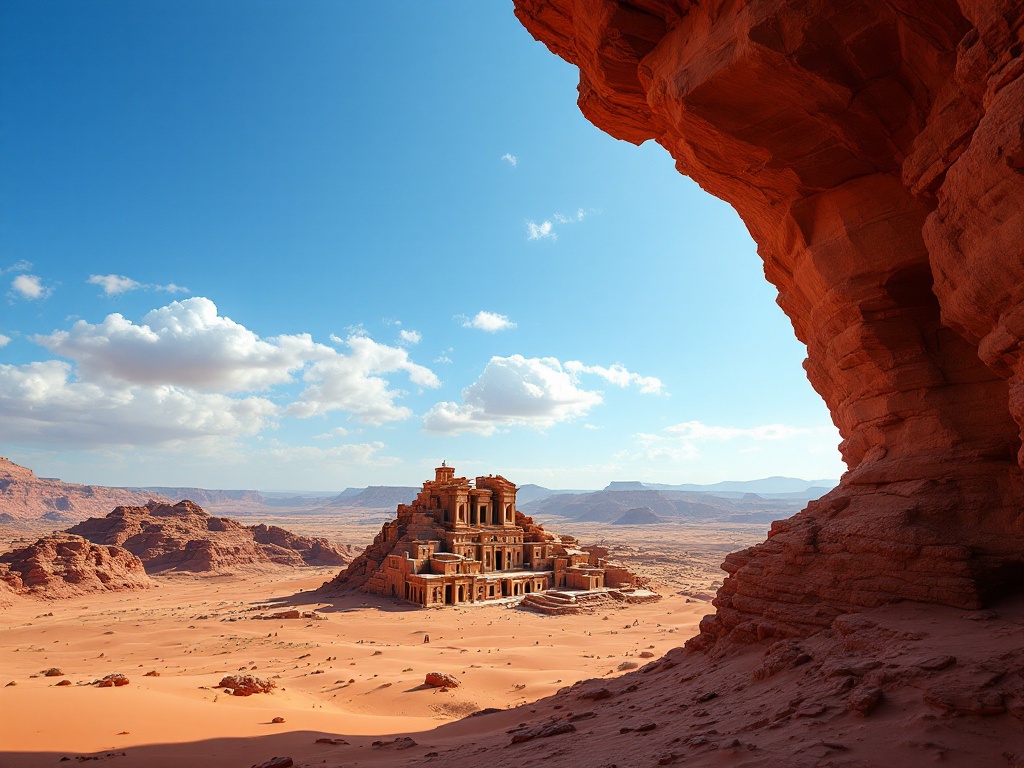Most Interesting Historical Places in Jordan to See on Your Trip
Discover Jordan’s breathtaking wonders! Explore the rose-red city of Petra, a UNESCO World Heritage Site, with its iconic Treasury and Monastery. Journey through Amman’s ancient Citadel and Roman Theatre, and wander the well-preserved Roman city of Jerash. Experience the unique desert landscapes of Wadi Rum and the spiritual significance of Mount Nebo. Uncover historical treasures from the Madaba Map to the Baptism Site of Jesus Christ. Explore castles, fortresses, and the captivating Desert Castles. Embark on an unforgettable adventure through Jordan’s rich history and stunning landscapes. Read on to plan your trip!
Important information

- Petra, a UNESCO World Heritage Site, is a Nabataean city carved into sandstone cliffs. It features iconic structures like Al-Khazneh (the Treasury) and Ad Deir (the Monastery), accessed through a narrow gorge called the Siq.
- Amman, Jordan’s capital, blends ancient ruins with modern life. Key sites include the Citadel, the Roman Theatre, and the historic downtown area of Al Balad.
- Jerash is one of the world’s best-preserved Roman cities outside of Italy, showcasing impressive temples, theaters, colonnaded streets, and intricate mosaics.
- Wadi Rum, known as the “Valley of the Moon,” offers a unique desert landscape with towering sandstone mountains and vast red sand dunes.
- Mount Nebo is a significant pilgrimage site where Moses viewed the Promised Land. The Moses Memorial Church, located here, houses stunning Byzantine mosaics.
Petra: The Rose Red City
Carved into sandstone cliffs, Petra, the Rose Red City, is a breathtaking spectacle.
This ancient Nabataean metropolis, now a testament to their ingenuity, once thrived as a bustling trade center.
Recognized as one of the New Seven Wonders of the World and a UNESCO World Heritage Site, Petra boasts remarkable architecture, including iconic structures like Al-Khazneh (the Treasury) and Ad Deir (the Monastery).
Adding to its mystique, the Siq, a narrow gorge, serves as the gateway to this rose-hued marvel.
The Treasury
Petra’s Treasury, also known as Al-Khazneh, is its most elaborate temple. Carved into sandstone cliffs, the impressive Hellenistic facade dates back to the first century BC. This intricate marvel was built by the Nabataeans, an ancient Arab people.
Monastery (Al Dayr)
Al Dayr, also known as the Monastery, is one of Petra’s most remarkable monuments. Carved directly into the cliff face, this massive Nabataean tomb is a truly awe-inspiring sight. Reaching Al Dayr involves a challenging climb, but the panoramic views from the top are worth the effort. From this vantage point, you can take in the magnificent spectacle of the entire surrounding area.
Siq and the Royal Tombs
The Siq, a narrow gorge, serves as a dramatic gateway to Petra, leading directly to the elaborate Royal Tombs carved into the sandstone cliffs. These tombs, such as the Urn, Silk, and Corinthian, are a testament to Nabataean ingenuity and impressive architectural skills. The Siq itself heightens the anticipation for the wonders within.
High Place of Sacrifice
High atop Petra, Jordan, sits the Nabataean High Place of Sacrifice, a site archaeologists believe was used for animal sacrifice and rituals. Two towering obelisks mark the location. Altars and rock-cut platforms provide stunning views of the surrounding mountains, a dramatic backdrop for ancient ceremonies. Imagine the breathtaking scene as rituals unfolded against this landscape.
Amman: Ancient and Modern
Amman, Jordan’s capital, seamlessly blends ancient history with modern life. Perched atop one of the city’s seven hills, the Citadel boasts Roman, Byzantine, and Islamic ruins, including the Temple of Hercules and the Umayyad Palace—vestiges of a storied past. The remarkably preserved Roman Theatre, still hosting events today as it did centuries ago, is another must-see landmark. Downtown, in the vibrant hub of Al Balad, traditional shops and cozy cafes nestle among numerous historical sites, perfectly capturing Amman’s dynamic spirit.
The Citadel and Roman Temple of Hercules
Located on Jebel al-Qal’a, one of Amman’s seven hills, the Amman Citadel showcases a captivating mix of Roman, Byzantine, and Umayyad ruins. The Temple of Hercules, a remarkable Roman-era structure, stands as one of the Citadel’s most impressive features.
Roman Theatre: A Cultural Landmark
Amman’s Roman Theatre is a remarkable testament to Jordan’s rich cultural heritage. This well-preserved ancient landmark offers visitors a captivating glimpse into history, making it a must-see attraction.
Al Balad – Downtown Amman
Amman’s historic downtown, Al Balad, is a vibrant blend of old and new. Explore traditional shops and restaurants while discovering historical gems like the Roman Theatre. This cultural heart of Amman is a must-see for any visitor.
Jerash: The Greco-Roman City
Jerash, a remarkably preserved Roman city outside of Italy, features stunning temples, theaters, and colonnaded streets. Explore attractions like the Oval Plaza, the South Theater, and the Temple of Artemis for a glimpse into Roman urban design. The city also hosts vibrant cultural events and festivals.
Hadrian’s Arch still stands tall among Jerash’s world-renowned Roman ruins. Colonnaded streets stretch throughout the city, leading to impressive structures like the Temple of Artemis and a large amphitheater, a testament to Roman engineering.
Beyond these grand structures, intricate mosaics and an archaeological museum offer insights into daily life in ancient Jerash. Jerash’s history spans beyond the Roman period. While the large amphitheater hosted performances and gatherings, the remains of a Byzantine church reveal the city’s Christian heritage, showcasing a rich blend of Roman and Byzantine influences.
Jerash Ruins: Best Preserved Roman Architecture
Journey back in time at Jerash, home to one of the world’s best-preserved Roman cities. Wander along colonnaded streets and discover ancient temples and theaters. Must-see sites include: the Oval Plaza, Hadrian’s Arch, the Temple of Artemis, and the impressive amphitheater. Intricate mosaics and an archaeological museum further enhance the experience. The city also hosts a captivating annual festival featuring performances and historical reenactments.
Roman Theatre and Byzantine Church
Jerash, Jordan is home to a remarkably well-preserved Roman Theatre, a stunning example of Roman architecture. Adjacent to it lies a Byzantine church, powerfully symbolizing a pivotal historical shift from Roman paganism to Christianity.
Wadi Rum: The Valley of the Moon
Wadi Rum, the “Valley of the Moon,” offers a truly unique desert landscape. Towering sandstone mountains and vast red sand dunes create a breathtaking, unforgettable vista.
Unique Desert Landscapes
Wadi Rum, also known as the Valley of the Moon, presents a striking desert panorama. Immense sandstone mountains emerge from the crimson sands, while narrow canyons wind their way through the terrain. The rocks, sculpted by wind and water erosion, create a dramatic, almost alien landscape. The view is simply breathtaking.
Mount Nebo: A Place of Pilgrimage
Mount Nebo, a revered pilgrimage site in Jordan, is traditionally considered the place where Moses first glimpsed the Promised Land. From its peak, visitors are treated to breathtaking views.
A historic memorial church, the Moses Memorial Church, stands on this sacred ground and houses stunning Byzantine mosaics. These intricate artworks add to the site’s spiritual significance, commemorating Moses’ view of the land he would never enter.
From Mount Nebo’s summit, the panorama unfolds: the Jordan Valley stretches below, the Dead Sea shimmers in the distance, and on a clear day, even Jerusalem can be seen. This vista powerfully evokes the Promised Land that Moses beheld.
Moses Memorial Church
Moses Memorial Church is located on Mount Nebo, marking the spot where Moses first saw the Promised Land.
The church houses beautiful ancient mosaics, which add to its historical importance.
Views of the Promised Land
From Mount Nebo, a breathtaking panorama unfolds, revealing the Jordan Valley, the Dead Sea, and distant Jerusalem. A memorial and church commemorate Moses’s view of the Promised Land. Within its walls, the church protects remarkable ancient mosaics, offering a vibrant window into history.
Madaba and the Mosaic Map
Madaba, the “City of Mosaics,” is renowned for its exquisite 6th-century mosaic map located within St. George’s Church. This intricate artwork depicts Jerusalem and other significant biblical locations. Local artisans contribute to the city’s vibrant artistic legacy by creating and selling stunning mosaic pieces. A nearby archaeological park offers further exploration, unveiling the region’s captivating history.
Church of Saint George at Madaba
Housed within Madaba’s Church of Saint George, the 6th-century Madaba Map is a remarkable mosaic depicting the Holy Land. This historically and religiously significant site offers a unique window into the region’s vibrant past and rich artistic heritage. The map itself provides an unparalleled glimpse into the ancient world.
Madaba Mosaic Map
Journey back in time with the Madaba Mosaic Map, a stunning 6th-century depiction of the Holy Land and Jerusalem. Located within St. George’s Church, this intricate floor mosaic is one of the oldest surviving maps of the region. Explore the ancient landscape with its rolling hills and valleys. Discover the locations of long-ago villages and towns. This remarkable artwork offers a unique window into the past.
The Baptism Site of Jesus Christ: Al-Magtas
Al-Maghtas, or Bethany Beyond the Jordan, is a UNESCO World Heritage site revered as the location of Jesus Christ’s baptism by John the Baptist. This profoundly significant event draws Christian pilgrims and those intrigued by biblical history to the Jordan River baptismal area and its surrounding archaeological remains.
UNESCO World Heritage Site
Al-Maghtas, a UNESCO World Heritage Site on the Jordan River, is revered as the place where John the Baptist baptized Jesus. Archaeological discoveries and longstanding religious traditions support this profound significance.
Jordan River Baptismal Area
John the Baptist baptized Jesus on the east bank of the Jordan River, a historically significant area known as the Jordan River Baptismal Area. This UNESCO World Heritage Site attracts Christian pilgrims worldwide. Archaeological finds, such as remnants of Roman and Byzantine churches, underscore the site’s historical importance.
The King’s Highway: A Journey Through Time
Journey through time along Jordan’s historic King’s Highway, a captivating route stretching north to south. Discover breathtaking scenery and fascinating stories etched in time as you explore this ancient road. Explore remarkable Crusader castles:
- Shobak Castle, built by King Baldwin I in 1115, offering panoramic views and impressive architecture.
- Karak Castle, constructed in 1142, another glimpse into Jordan’s rich past.
These fortresses represent just a fraction of the historical treasures found along the King’s Highway, a testament to Jordan’s enduring legacy. Experience an unforgettable journey.
Shobak Castle
Shobak Castle, also known as Montreal, is located in Shobak, Jordan. King Baldwin I built this crucial Crusader fortress, the first of its kind in the region, in 1115. It controlled vital communication and trade routes for the Crusader kingdom until Saladin’s forces besieged and captured it in 1189.
Karak Castle: A Historic Fortress
Karak Castle, a Crusader fortress in Karak, Jordan, offers a fascinating glimpse into medieval military architecture. This strategically important stronghold played a crucial role in the Crusader states of the region.
Ajloun Castle: An Islamic Fortress
Ajloun Castle’s strategic location: Perched atop a hill within Jordan’s Ajloun Forest Reserve, 70 kilometers (44 miles) northwest of Amman. It commands breathtaking panoramic views.
Historical Significance: Originally built in 1184 by Izz al-Din Usama, a general in Saladin’s army. The castle played a crucial role in controlling valuable iron mines and safeguarding vital trade routes between Jordan and Syria.
Architectural Evolution: Initially featuring four corner towers and a single gate, the fortress expanded in the 13th century with two additional towers added after Mongol attacks.
Dual Purpose: The castle served not only as a defensive stronghold but also as a palace.
Modern-Day Exploration: Today, Ajloun Castle welcomes visitors to explore its fascinating chambers, towers, and ramparts, offering a glimpse into the ingenuity of Islamic military architecture.
Panoramic Views and History
Ajloun Castle’s Majestic Location. Perched atop a hill overlooking the Jordan Valley, the 12th-century Ajloun Castle offers breathtaking panoramic views.
Historical Significance. Built by Izz al-Din Usama, one of Saladin’s generals, this Islamic fortress played a crucial role in defending the region against Crusader advances.
Strategic Advantage. Its strategic location offered visibility for miles, a key advantage in medieval power struggles. The castle’s fascinating history reflects this turbulent era.
Umm Qais: The Ancient City of Gadara
Umm Qais, formerly Gadara, is a captivating Decapolis city offering a unique glimpse into antiquity. Explore the remnants of theaters, churches, shops, and paved roads, revealing much about the Hellenistic and Roman periods. The city also boasts breathtaking views overlooking the Sea of Galilee.
The remarkably well-preserved Roman theater at Umm Qais almost allows you to envision past performances.
Byzantine church ruins dot the landscape, whispering tales of a different era.
Evidence of paved roads and colonnaded streets showcases the city’s impressive urban planning.
It’s truly a remarkable site.
Theatre, Churches, and Paved Roads
Journey through history in Umm Qais, a city steeped in ancient wonders. Explore the remarkably preserved Roman theatre, discover the remnants of Byzantine churches, and wander along original paved roads. These fascinating structures reveal Umm Qais’s rich past and its prominence during the Roman and Byzantine periods. The city’s thriving legacy endures to this day.
Umm ar-Rasas: A Mosaic Haven
The remarkably well-preserved Byzantine mosaics at Umm ar-Rasas, a UNESCO World Heritage site, offer intricate glimpses into ancient cities and biblical narratives. For instance, the mosaic floor of the Church of Saint Stephen presents a detailed map of the Holy Land and surrounding regions. These exceptional mosaics provide invaluable insights into the past.
Well-Preserved Mosaics
The UNESCO World Heritage site of Umm ar-Rasas is home to remarkable Byzantine mosaics, particularly those found within the Church of Saint Stephen. These incredibly well-preserved artworks showcase a variety of scenes.
- Vibrant cityscapes,
- Diverse animals,
- Intricate geometric designs.
Beyond their aesthetic beauty, the mosaics offer invaluable insights into the artistic and cultural landscape of the Byzantine period, representing a true historical treasure.
Jordan’s Desert Castles
Scattered throughout Jordan’s desert landscape are the Desert Castles, fascinating relics of early Islamic architecture and ingenuity. These structures served a variety of purposes, including:
- Peaceful retreats,
- Invigorating bathhouses,
- And strategic hunting lodges.
Among these architectural marvels are Qasr Al-Harranah, Qasr Amra, and Qasr Bashir. Qasr Amra, recognized as a UNESCO World Heritage Site, stands out for its exceptionally well-preserved and captivating frescoes. These castles offer a unique glimpse into a rich and vibrant past, showcasing remarkable architectural achievements and artistic expression.
Qasr Al-Harranah
Qasr Al-Harranah, a square fortress from the Umayyad period, stands among Jordan’s desert castles. This impressive structure likely served as an administrative center or perhaps a caravanserai offering respite to weary travelers. The castle is a striking example of Umayyad architecture.
Qasr Amra: A UNESCO World Heritage Site
Qasr Amra, a UNESCO World Heritage Site nestled in the Jordanian desert, is renowned for its vibrant frescoes. These depict scenes of daily life, animals, and the celestial wonders above. This desert castle served as a luxurious retreat for the Umayyad caliphs.
Qasr Bashir
Qasr Bashir, a remarkably well-preserved Roman and Byzantine fortress in Jordan’s eastern desert, offers a glimpse into the military might of these empires. Its impressive walls, towers, and gates still stand, showcasing a fascinating example of military architecture.








